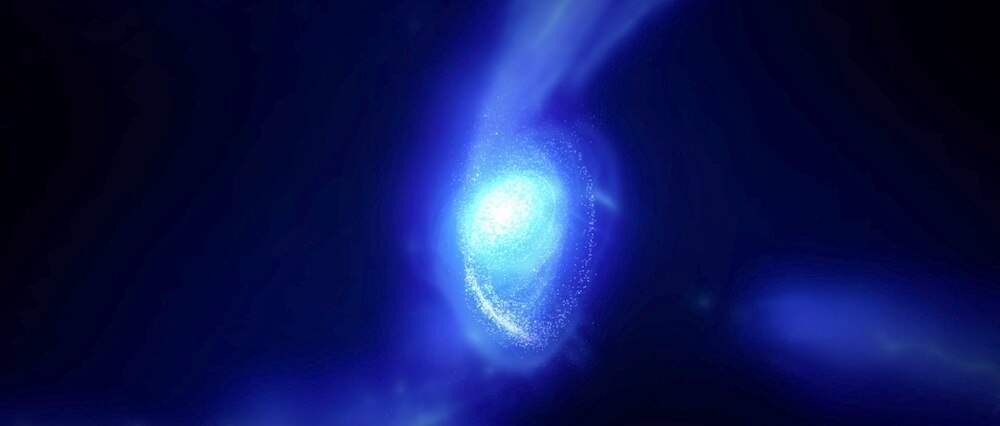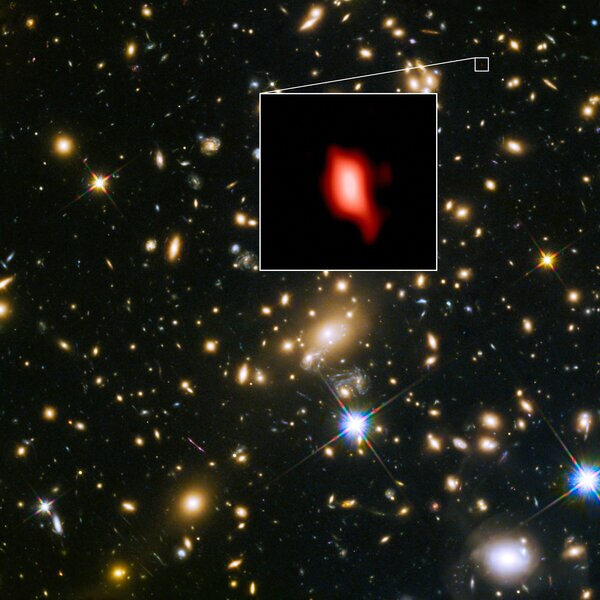Create a free profile to get unlimited access to exclusive videos, sweepstakes, and more!
This galaxy was already grown-up and spinning 13.3 billion years ago!
JD1 shows signs of coherent rotation when it was less than 500 million years old.

A galaxy so distant we see it practically at the edge of the observable Universe has been seen to act like a more fully grown galaxy: Observations show it’s rotating, spinning in a way similar to our own Milky Way, despite us seeing it as it was just 500 million years after the Big Bang!
The galaxy is called MACS1149-JD1 — or just JD1 for short — and its light took about 13.3 billion years to reach us. Given the Universe is only about 13.8 billion years old, we see this galaxy as it was when it was very young indeed.
It’s so far away that normally it would be far too faint to see, but it happens to lie behind a very massive galaxy cluster called MACSJ1149.5+223. That cluster is only about 5 billion light-years away from us, much closer to us than JD1, and that’s fortunate: The immense gravity of the combined galaxies in the cluster acts like a lens, bending and amplifying the light from JD1, making it bright enough to see. It also magnifies the image of JD1, allowing us to see it in more detail, just like a lens does.
JD1 has been studied before, and amazingly one paper showed that the stars in the galaxy were already forming just 250 million years after the birth of the Universe itself. In another study, astronomers used the Atacama Large Millimeter/submillimeter Array, or ALMA, to observe the galaxy at a wavelength of about 88 microns, and saw light from oxygen atoms glowing brightly. Oxygen is made inside massive stars and expelled as they explode at the ends of their lives, so some of these stars had already been born, aged, and died by the time we see this galaxy, which is amazing.
The new work expands on those observations [link to paper]. The astronomers used ALMA to observe oxygen in JD1 at 88 microns again, but this time took a total of nearly 10 hours of observations, compared to just 2 hours in the earlier ones. The longer the observation the more light the telescope collects, making structure and details easier to see. Although it’s still fairly low resolution — we’re talking about a galaxy that’s very far away, after all — they can see structures roughly 1,000 light-years across in JD1.
What they found is a clear signal that some of the light being emitted by oxygen is emitted by material moving toward us, and some by material moving away from us. That’s a pretty good indication of rotation: An object that’s spinning will have half of it moving toward us and half moving away, creating a Doppler shift in its light. It’s this shift the astronomers saw (after accounting for the enormous redshift of the galaxy itself, swept away from us by the expansion of the Universe).
The galaxy is small, only about 3,000 light years across, which isn’t too surprising. At that time in the Universe galaxies had only just started forming by accumulating gas, so they hadn’t had enough time to grow as huge as, say, our Milky Way, which is about 120,000 light-years wide. It’s also in turn much less massive, too, only about 650 million times the mass of the Sun; the Milky Way for comparison is over 1,000 times more massive than JD1.
A rotating galaxy spins at a rate that depends on its mass, since that’s what determines the gravity, and it’s the gravity that holds the stars in their orbits. JD1 spins at a rate of a little under 50 kilometers per second, compared to over 200 for the Milky Way. So in every way this is a galaxy that’s still young and growing, but already showing signs of adulthood. Think of it as an awkward teen.
All the physical modeling the astronomers did shows that JD1 is consistent with being a disk galaxy, like a spiral galaxy, with stars in it that formed about 300 million years ago, which matches well with what was seen in the earlier work using a different method to get the stellar age. It also means that even at this young age it’s possible for galaxies to form themselves into disks, which is a pretty cool result.
This all makes JD1 the most distant galaxy ever seen with signs of rotation, as well as the farthest in which we can detect structure and motion. Everything found is consistent with models of how galaxies should behave in the very early Universe, too, which is encouraging. It means we’re likely on the right track in understanding what the cosmos was like when it was a wee baby. Mysteries are fun in science, but the occasional sign that we’re doing the right thing is nice, too.



























